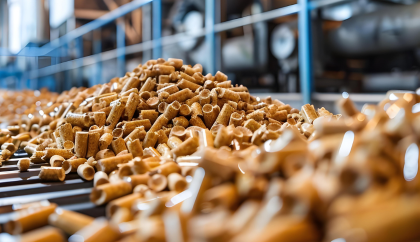Step-by-Step Guide for Large-Scale Manufacturing
Wood pellets are one of the most popular renewable energy sources, especially in the industrial sector. They are made from compressed organic materials, primarily wood waste, and are used in large-scale heating systems, power plants, and even as a feedstock for animal feed. The industrial production of wood pellets involves advanced machinery and precise processes to create high-quality, dense pellets that are ready for commercial use.
In this article, we’ll take a look at the essential steps involved in industrial wood pellet production, from preparing the raw materials to the final quality control process.
1. Raw Material Preparation
The first step in industrial wood pellet production is sourcing and preparing the raw materials. The most common raw materials for wood pellets are sawdust, wood shavings, wood chips, and other wood waste products from industries like sawmills and carpentry. Other biomasses such as straw, agricultural residues, or even recycled wood can also be used, depending on the available resources and intended market.
Steps for Raw Material Preparation:
- Sorting and cleaning: Remove any contaminants such as metals, plastics, and dirt.
- Size reduction: Use large-scale wood chippers or hammer mills to reduce the material size to smaller, uniform particles.
- Drying: Wood fibers typically have a high moisture content, which needs to be reduced to an optimal level (around 10-15%) using industrial dryers to prevent mold formation and ensure efficient pelletization.
2. Grinding and Milling
Once the raw material is prepared, it needs to be finely ground into a powder-like consistency. This step is crucial because finer material compresses more easily, improving the quality of the pellets. This is usually done in a hammer mill or roller mill.
Grinding Process:
- Feed the preprocessed wood waste (sawdust, shavings, etc.) into the mill.
- The mill grinds the materials into a uniform size—typically less than 1mm in diameter.
- The finely ground material ensures that the pellets can form more tightly and maintain their integrity.
3. Pelletizing (Compression into Pellets)
The heart of industrial wood pellet production is the pelletizing process. Here, the fine wood particles are compressed into small cylindrical pellets using a pellet mill machine. The process involves applying high pressure and heat, which causes the lignin in the wood to soften and bind the particles together, creating a solid, durable pellet.
Pelletizing Steps:
- Feeding the ground material: The finely ground material is fed into a large pellet mill, where it is compressed through a die with small holes.
- Compression and extrusion: The machine applies high pressure, pushing the material through the die holes. This action causes the raw material to take the shape of small pellets.
- Cooling: The pellets come out of the machine hot and moist, so they must be cooled before they can be safely stored or packaged.
4. Cooling and Drying the Pellets
After extrusion, the pellets are still hot and moist. They need to be cooled and dried to a moisture content of around 8-10%, which is optimal for storage and transportation.
Cooling and Drying Process:
- The pellets are passed through cooling systems such as rotary coolers or fluidized bed coolers, where they are gently cooled using ambient air.
- If necessary, drying can be done in a high-temperature dryer to further reduce excess moisture and ensure pellet stability.
5. Screening and Sorting
After the pellets have cooled down, they need to be screened and sorted to remove any fines (broken or small pellets) and ensure the pellets are uniform in size. The ideal size for industrial pellets is around 6-8 mm in diameter.
Screening Process:
- Pellets are passed through vibrating screens that separate the fine particles from the properly formed pellets.
- Any undersized or broken pellets are removed and can be reprocessed.
6. Packaging and Storage
Once the wood pellets are screened, they are ready for packaging and storage. In large-scale production, industrial wood pellets are typically stored in silos or large warehouses before being packaged into bags or transported in bulk.
Packaging and Storage:
- Bulk storage: Pellets can be stored in large silos or warehouses until they are ready for shipment.
- Packaging: For commercial use, pellets are often packaged into bags or bulk containers for easy handling and transport.
- Storage conditions: Wood pellets should be stored in dry conditions to prevent moisture absorption and ensure quality.
7. Quality Control and Testing
Maintaining a consistent quality is vital for industrial wood pellets, especially since they are used in large heating systems or power plants. Quality control ensures the pellets meet the required standards for energy output, density, and moisture content.
Quality Control Checks Include:
- Pellet durability (hardness): Testing the ability of the pellet to resist breaking.
- Moisture content: Ensuring the moisture level is within the optimal range (8-10%).
- Energy content: Measuring the calorific value to ensure the pellets provide enough energy per unit of weight.
- Size uniformity: Ensuring pellets are consistently sized and free from fines.
The industrial production of wood pellets involves a series of complex processes designed to ensure that the final product is of high quality and consistency. From raw material preparation and grinding to the pelletizing process, cooling, and quality control, every step is essential to producing pellets that are ready for commercial use in heating systems, power generation, or as animal feed.
With the growing demand for renewable energy and eco-friendly fuel sources, the wood pellet industry is likely to continue expanding. If you’re interested in starting your own wood pellet production or improving your existing setup, understanding the entire process is crucial to success.


thanks bro very helpful
Thank you brothers